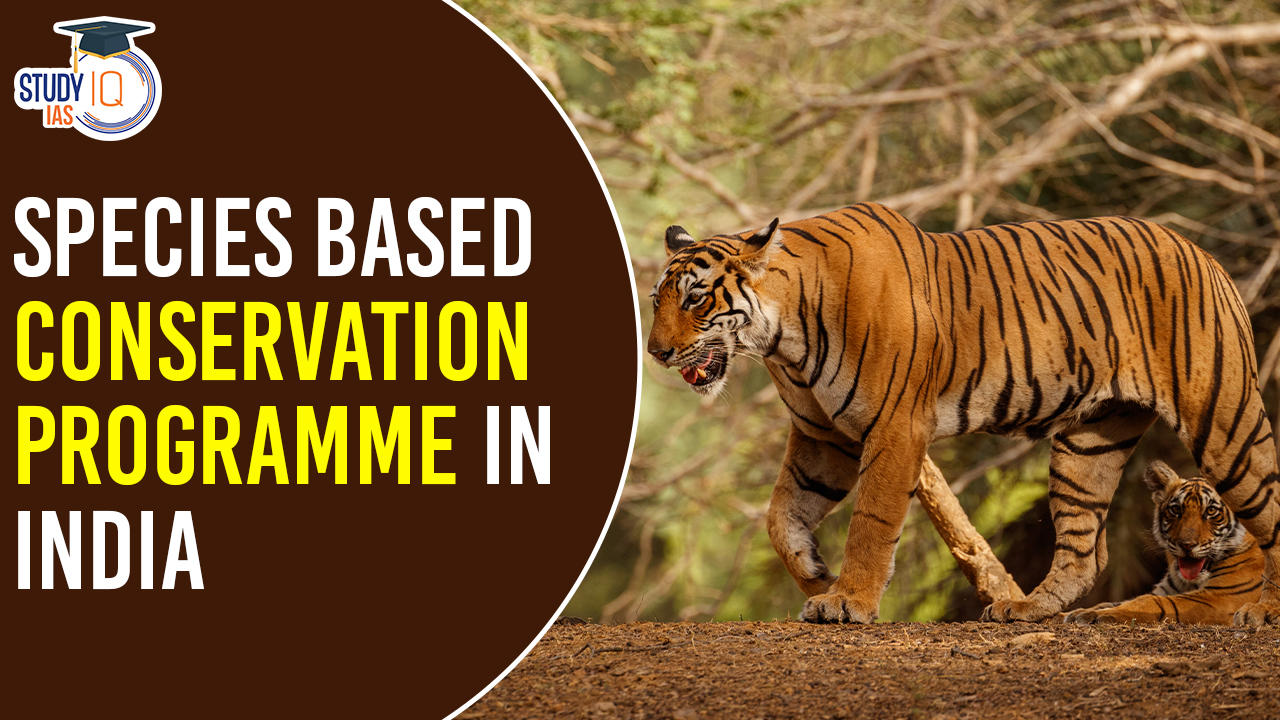Table of Contents
Species Based Conservation Programme in India
Despite typically referring to the “maintenance, protection, or restoration of the natural environment and animals,” conservation is not specified in Indian statutes. In this period of climate change, nature, the environment, and wildlife are being destroyed at an alarming rate. As a result of industrialisation and globalization, natural resources are irreversibly being depleted.
According to Section 2(37) of the Wildlife Protection Act of 1972, “wildlife” is defined as any animal, whether terrestrial or aquatic, and any vegetation that is a part of any habitat.
Various Species Based Conservation Programme in India
For protecting the critically endangered and other threatened species of animal and plant, the Government of India has adopted many steps, laws, and policy initiatives
Project Tiger
Project Tiger is a Centrally Sponsored Scheme that has been launched by the Indian Government at Palamau Tiger Reserve in Jim Corbett National Park in 1973 for protecting tigers in their habitats from varied threats. Project Tiger has the following objectives:
- Ensuring the maintenance of the population of the Tiger in their habitats.
- For preserving, for all times, the areas of such biological importance as a national heritage for the benefit, education and enjoyment of people.
Conservation Status of Tiger
- Indian Wildlife (Protection) Act, 1972: Schedule I
- International Union for Conservation of Nature (IUCN) Red List: Endangered.
- Convention on International Trade in Endangered Species of Wild Fauna and Flora (CITES): Appendix I.
In 1973–1974, the Project had nine reserves, and it presently has fifty reserves. The Initiative has been quite successful in regenerating the tiger population and habitat in the protected areas.
Project Snow Leopard
The Himalayan region, as well as states like Jammu & Kashmir, Uttarakhand, Arunachal Pradesh, Sikkim, and Himachal Pradesh, are home to snow leopards. The species has the best conservation status on a national and international level because it is listed in CITES and CMS.
International Snow Leopard Day is commemorated annually on October 23. 2019 saw the release of the “First National Protocol on Snow Leopard Population Assessment” by the Indian government. Utilizing technologies like camera traps and research surveys is required for this.
Conservation Status
- The snow leopard is listed as Vulnerable on the Red List of Endangered Species maintained by the World Conservation Union.
- The Convention on International Trade in Endangered Species (CITES) also lists it in Appendix I.
- It is listed in Schedule I of the Indian Wildlife (Protection) Act of 1972.
- Additionally, it is protected under the Convention on Migratory Species (CMS), providing it the highest level of protection both internationally and in India.
Project Elephant
A government-funded initiative called Project Elephant was started in 1992. Elephants are not endangered like tigers are; rather, they are threatened with attrition. In states where wild elephant populations roam freely, the project aims to aid in managing and protecting elephant populations.
To protect elephants around the nation, the Elephants’ Protection Act of 1879 was also created. Only 65% of the elephant corridors in India are protected, despite the country having about 27,000 elephants spread throughout 26 elephant reserves. Elephants must be protected since they are considered a part of the national heritage of Country.
Conservation Status
- IUCN Red List: Endangered.
- Wildlife (Protection) Act, 1972: Schedule I.
- CITES Appendix I
Indian Rhino Vision 2020
Aiming to produce a wild population of at least 3,000 bigger one-horned rhinos dispersed among seven protected areas in the Indian state of Assam by the year 2020, the ambitious Indian Rhino Vision 2020 program was introduced in 2005. The seven protected areas include Kaziranga, Pobitora, Orang National Park, Manas National Park, Laokhowa Wildlife Sanctuary, Burachapori Wildlife Sanctuary, and Dibru Saikhowa Sanctuary.
A key component of IRV2020 was moving rhinos from densely populated areas like Kaziranga NP to those that needed additional rhinos, like Manas NP.
Conservation Status
- The Greater One-Horned (or Indian) rhino is vulnerable, whereas the Javan and Sumatran rhinos are both critically endangered, according to the IUCN Red List.
- Each of the three is included in CITES Appendix I.
- The Wildlife Protection Act of 1972 includes protection for the larger one-horned rhinoceros in Schedule I.
Project Hangul
In the 1970s, the administrations of Jammu and Kashmir created a plan to safeguard the Kashmir Red Stag and its habitat, working with the World Wildlife Fund (WWF) and the International Union for Conservation of Nature (IUCN). The project was known as Project Hangul.
Northern India is home to the Central Asian Red Deer subspecies known as the Hangul, commonly referred to as the Kashmir Red Stag. The deep riverine woods of the Kashmir Valley, Himachal Pradesh, Sindh Valley, Dachigam National Park, and Kishtwar forests are where it is most frequently found.
- After Hanguls were listed to the IUCN’s list of critically endangered species, the endeavor got under way. Dachigam National Park’s 141 square kilometers contain the species.
- Since the 1950s, it has been regarded as one of the most threatened animal species on the Indian subcontinent.
- The Wildlife (Protection) Act of 1972’s Schedule I lists the Hangul as a protected species.
- Building enclosures for the species’ artificial breeding was the project’s main objective.
Crocodile Conservation Initiative
An increase in indiscriminate killings in India put crocodilians in danger. Their population drastically decreased as a result of poaching for economic gain. In addition, habitat has been lost as a result of accelerated industrialisation and development.
Project Crocodile was started in 1975 as a reaction to this circumstance. The focus was mostly on captive breeding and upbringing. In conjunction with the Food and Agricultural Organization and the United Nations Development Fund, the Indian government began the effort. The project’s adoption has increased crocodile numbers, sparing them from extinction. Katerniaghat and the National Chambal Sanctuary are two examples of the protected areas.
Conservation Status
Crocodiles are classified into three types:
- Gharial
- IUCN Red List- Critically Endangered
- CITES- Appendix I
- Wildlife Protection Act, 1972 Schedule I
- Mugger
- IUCN Red List- Vulnerable
- CITES- Appendix I
- Wildlife Protection Act, 1972 Schedule I
- Saltwater Crocodile
- IUCN Red List- Least Concern
- CITES -Appendix I
- Wildlife Protection Act, 1972 Schedule I
The Manipur Brow-antlered Deer Project
This was begun in Manipur in 1981 to protect the critically endangered brow-antlered deer (Cerevus eldi eldi).
- Manipur’s national animal is the sangria, also known as the brow-antlered deer.
- In the winter, the animal’s coat is a deep reddish brown color, whereas in the summer it is much paler.
- These creatures were formerly widely dispersed over ecosystems in south and southeast Asia. They are native to Cambodia, China, India, Laos, and Myanmar.
- Deer habitat can range from shrubland and grassland to dry woods and wetlands, depending on the country.Only the renowned Loktak Lake in Manipur is home to these creatures.
- Hunting presents an extra difficulty in Manipur, where habitat loss has been a problem for the conservation of this deer on a global scale.
Conservation Status
- Endangered according to the IUCN Red List.
- WPA 1972: Schedule-I
- CITES Appendix I
Project Himalayan Musk Deer
This was launched in 1981 to protect the threatened and nearly extinct musk deer. Positive results have been seen through captive breeding.
Man has hunted the musk deer, which was once common throughout the Himalayas, in order to use its musk to make perfumes and medicines. This led to a sharp decline in its population, which was exacerbated by habitat deterioration. Under the International Union for Conservation of Nature (IUCN) and Natural Resources’ Endangered Deer Programme, a conservation project was launched at the Kedarnath sanctuary in Uttar Pradesh (now Uttarakhand) with the help of the Government of India.
Conservation Status
- It is under lower risk (near threatened) status of the IUCN Red List of threatened species
- Appendix I of Convention on International Trade of Endangered flora and fauna (CITES)
- Protected species of National Parks and Wildlife Conservation Act, 1973, Nepal (HMG/Nepal 2002).
The Gir Lion Sanctuary Project
The Gir forest in Gujarat is currently home to the Asiatic lion, which once inhabited the northern and central Indian subcontinent. About 200 Asiatic lions reside in this last habitat for the species, which was severely threatened by overgrazing by domestic livestock, the extinction of prey species, etc. In 1972, the Gujarat State Government established a management structure, replete with conservation guidelines, for the Gir lion sanctuary. The central government provides support for enhancing and protecting habitat.
Conservation Status
- IUCN Red List: Endangered
- CITES: Appendix I
- Wildlife (Protection) Act 1972: Schedule I
Sea Turtle Project
The majority of the Olive Ridley Turtle population in the globe migrates to Indian coastal waters every winter to reproduce, particularly along the eastern coast.
The MoEF initiated the Sea Turtle Conservation Project in 1999 in collaboration with UNDP, with the Wildlife Institute of India, Dehradun serving as the implementing agency, with the aim of protecting olive ridley turtles and other endangered sea turtles.
Ten coastal states in the nation are involved in the initiative, with Orissa receiving special attention. The research helped identify nesting and breeding habitats along the shoreline, create an inventory map of sea turtle breeding sites, and develop policies to protect and reduce turtle mortality.
Conservation Status
- Protection Status Wildlife Protection Act of 1972 Schedule I
- IUCN Red List -Vulnerable
- CITES Appendix I
Ganges Dolphin
The Ministry of Environment and Forests has named the Ganges River Dolphin the country’s official aquatic animal.
The River Dolphin lives in the Ganges-Brahmaputra-Meghna and Karnaphuli-Sangu river systems of Nepal, India, and Bangladesh.
The Ganges Dolphin is one of only four “obligate” freshwater dolphins in the world, the others being the “boto” of the Amazon River in Latin America and the “baiji” of the Yangtze River in China.
These four species of marine dolphin only live in rivers and lakes, whereas the majority of marine dolphin species have ranges that include some freshwater habitats.
Conservation Status
- Indian Wildlife (Protection), Act 1972: Schedule I.
- International Union for the Conservation of Nature (IUCN): Endangered.
- Convention on International Trade in Endangered Species (CITES): Appendix I (most endangered).
- Convention on Migratory Species (CMS): Appendix II (migratory species that need conservation and management or would significantly benefit from international cooperation).
India’s Ganges River Dolphin is in danger from oil poaching, unintentional entanglement in fishing nets, river water pollution, and siltation. Additionally, population isolation is being caused by river modifications like barrages and dams.
Species Based Conservation Programme in India UPSC
It is clear that sustaining ecological stability depends on protecting animals. The ecology has suffered serious harm as a result of human activities expanding into these animals’ habitats. There has to be stricter enforcement of wildlife laws. Projects for wildlife conservation seek to protect and utilize natural resources sustainably so that subsequent generations may profit from them.
An effort has been made to lessen the harm and avert further disruptions through these programs for wildlife protection. humans must take care to avoid harming environment because humans are the most intelligent species on the world. The global community could be seriously threatened by species extinction. The entire planet suffers when a vital part of the ecosystem is destroyed.


 Delimitation, Women's Quota
Delimitation, Women's Quota
 A collective effort towards peace in Mya...
A collective effort towards peace in Mya...
 A Picture Of A Growing Economic Divide I...
A Picture Of A Growing Economic Divide I...



















